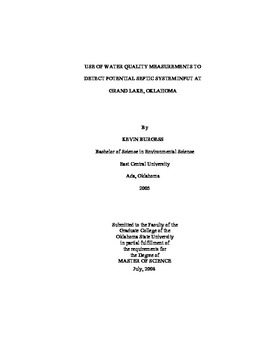| dc.contributor.advisor | Bidwell, Joseph R. | |
| dc.contributor.author | Burgess, Kevin | |
| dc.date.accessioned | 2014-04-15T22:31:35Z | |
| dc.date.available | 2014-04-15T22:31:35Z | |
| dc.date.issued | 2008-07-01 | |
| dc.identifier.uri | https://hdl.handle.net/11244/9546 | |
| dc.description.abstract | The Pensacola Hydroelectric Project impounds the Neosho, Elk, and Spring Rivers in northeastern Oklahoma to form Grand Lake O' the Cherokees (Grand Lake). Grand Lake has extensive near-shore development with the majority of homes using septic systems to treat household wastewater. The soils that surround much of the lake are only marginally adequate to retain/treat septic leachate, so it is possible that effluent from some septic systems could reach the surface water of Grand Lake. This study investigated the relationship between factors that could increase the potential for septic system failure (housing density and age) and common water quality parameters that could indicate the presence of septic effluent in surface waters. A geographic information system (GIS) database was used categorize selected sites along the Grand Lake shoreline based on housing density and age. Water samples were taken at these sites through late spring, summer and early fall of 2006 and early spring, summer, and early fall of 2007, and a suite of water physical, chemical and bacterial parameters were measured. Flow regimes between the two field seasons were significantly different, with 2006 having low flow conditions and 2007 with record-breaking precipitation and flooding. Findings and Conclusions: No clear relationship was observed between water quality and the categories used to differentiate housing age and density, although site comparisons indicated a decreasing longitudinal gradient towards the dam for parameters such as total phosphorous, orthophosphate, nitrate, nitrite and ammonium. High variability was also observed for some water quality parameters within sample coves. Sampling with Polar Organic Chemical Samplers (POCIS) indicated organic wastewater compounds at most sites sampled with the most detected at the outfall of a wastewater treatment facility. Stable isotope (?N-15) indicates some potential nitrogen enrichment of some sites, but a more definitive investigation with increased replication is needed to better evaluate this relationship. Overall, no clear links between risk factors for septic system failure and water quality indicators of this failure were indicated in this study. Methods such as microbial source tracking and groundwater investigation may be necessary to characterize the relationship of septic systems and water quality. | |
| dc.format | application/pdf | |
| dc.language | en_US | |
| dc.publisher | Oklahoma State University | |
| dc.rights | Copyright is held by the author who has granted the Oklahoma State University Library the non-exclusive right to share this material in its institutional repository. Contact Digital Library Services at lib-dls@okstate.edu or 405-744-9161 for the permission policy on the use, reproduction or distribution of this material. | |
| dc.title | Use of Water Quality Measurements to Detect Potential Septic System Input at Grand Lake, Oklahoma | |
| dc.type | text | |
| dc.contributor.committeeMember | Storm, Dan | |
| dc.contributor.committeeMember | Carter, Brian | |
| dc.contributor.committeeMember | Townsend, Darrell | |
| osu.filename | Burgess_okstate_0664M_2802.pdf | |
| osu.college | Agricultural Sciences and Natural Resources | |
| osu.accesstype | Open Access | |
| dc.description.department | Environmental Sciences Program | |
| dc.type.genre | Thesis | |
